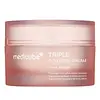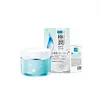What's inside
What's inside
 Key Ingredients
Key Ingredients

 Benefits
Benefits

 Concerns
Concerns

 Ingredients Side-by-side
Ingredients Side-by-side

Water
Skin ConditioningGlycerin
HumectantDipropylene Glycol
HumectantCetearyl Alcohol
EmollientCyclopentasiloxane
EmollientCaprylic/Capric Triglyceride
MaskingTriethylhexanoin
MaskingHydrogenated Polydecene
Emollient1,2-Hexanediol
Skin ConditioningNiacinamide
SmoothingHydrogenated Poly(C6-14 Olefin)
EmollientCyclohexasiloxane
EmollientGlyceryl Stearate Se
EmulsifyingDioscorea Japonica Root Extract
Skin ConditioningAesculus Hippocastanum Extract
AntioxidantLaminaria Japonica Extract
Skin ProtectingEclipta Prostrata Leaf Extract
Skin ConditioningCollagen Extract
Skin ConditioningHydrogenated Lecithin
EmulsifyingArgania Spinosa Kernel Oil
EmollientSodium Hyaluronate
HumectantCetearyl Olivate
C12-16 Alcohols
EmollientDimethicone
EmollientGlyceryl Stearate
EmollientPEG-100 Stearate
Microcrystalline Cellulose
AbsorbentCetearyl Glucoside
EmulsifyingSorbitan Olivate
EmulsifyingFructose
HumectantHydroxyethyl Acrylate/Sodium Acryloyldimethyl Taurate Copolymer
Emulsion StabilisingButylene Glycol
HumectantSqualane
EmollientPalmitic Acid
EmollientBetaine
HumectantCellulose Gum
Emulsion StabilisingHydrolyzed Corn Starch
HumectantPolysorbate 60
EmulsifyingEthylhexylglycerin
Skin ConditioningAdenosine
Skin ConditioningHydrogenated Polyisobutene
EmollientBeta-Glucan
Skin ConditioningAlcohol
AntimicrobialDisodium EDTA
Isononyl Isononanoate
EmollientPolyglyceryl-10 Stearate
Skin ConditioningSorbitan Isostearate
EmulsifyingSucrose
HumectantStearic Acid
CleansingButyrospermum Parkii Butter
Skin ConditioningPolyglyceryl-2 Dipolyhydroxystearate
Skin ConditioningFructooligosaccharides
HumectantInulin Lauryl Carbamate
Emulsion StabilisingHydrolyzed Hyaluronic Acid
HumectantCitric Acid
BufferingDisodium Stearoyl Glutamate
CleansingCollagen
MoisturisingHydrolyzed Elastin
EmollientHyaluronic Acid
HumectantTocopherol
AntioxidantLeuconostoc/Radish Root Ferment Filtrate
AntimicrobialParfum
MaskingPotassium Sorbate
PreservativeLinalool
PerfumingBenzyl Salicylate
PerfumingLimonene
PerfumingHydroxycitronellal
PerfumingWater, Glycerin, Dipropylene Glycol, Cetearyl Alcohol, Cyclopentasiloxane, Caprylic/Capric Triglyceride, Triethylhexanoin, Hydrogenated Polydecene, 1,2-Hexanediol, Niacinamide, Hydrogenated Poly(C6-14 Olefin), Cyclohexasiloxane, Glyceryl Stearate Se, Dioscorea Japonica Root Extract, Aesculus Hippocastanum Extract, Laminaria Japonica Extract, Eclipta Prostrata Leaf Extract, Collagen Extract, Hydrogenated Lecithin, Argania Spinosa Kernel Oil, Sodium Hyaluronate, Cetearyl Olivate, C12-16 Alcohols, Dimethicone, Glyceryl Stearate, PEG-100 Stearate, Microcrystalline Cellulose, Cetearyl Glucoside, Sorbitan Olivate, Fructose, Hydroxyethyl Acrylate/Sodium Acryloyldimethyl Taurate Copolymer, Butylene Glycol, Squalane, Palmitic Acid, Betaine, Cellulose Gum, Hydrolyzed Corn Starch, Polysorbate 60, Ethylhexylglycerin, Adenosine, Hydrogenated Polyisobutene, Beta-Glucan, Alcohol, Disodium EDTA, Isononyl Isononanoate, Polyglyceryl-10 Stearate, Sorbitan Isostearate, Sucrose, Stearic Acid, Butyrospermum Parkii Butter, Polyglyceryl-2 Dipolyhydroxystearate, Fructooligosaccharides, Inulin Lauryl Carbamate, Hydrolyzed Hyaluronic Acid, Citric Acid, Disodium Stearoyl Glutamate, Collagen, Hydrolyzed Elastin, Hyaluronic Acid, Tocopherol, Leuconostoc/Radish Root Ferment Filtrate, Parfum, Potassium Sorbate, Linalool, Benzyl Salicylate, Limonene, Hydroxycitronellal
Water
Skin ConditioningGlycerin
HumectantPropanediol
SolventPentylene Glycol
Skin Conditioning1,2-Hexanediol
Skin ConditioningIsononyl Isononanoate
EmollientSodium Acrylates Crosspolymer-2
AbsorbentPhenoxyethanol
PreservativeCetearyl Alcohol
EmollientTrehalose
HumectantUrea
BufferingEthylhexylglycerin
Skin ConditioningStyrene/Vp Copolymer
Hydrogenated Phosphatidylcholine
EmulsifyingSerine
MaskingCitrus Sinensis Peel Extract
PerfumingCitric Acid
BufferingCarnosine
Skin ConditioningBifida Ferment Lysate
Skin ConditioningGlyceryl Polyacrylate
Algin
MaskingCaprylyl Glycol
EmollientSodium Hyaluronate
HumectantPullulan
Disodium Phosphate
BufferingCitrus Limon Peel Oil
MaskingPelargonium Graveolens Flower Oil
MaskingElettaria Cardamomum Seed Oil
MaskingCitrus Aurantium Bergamia Fruit Oil
MaskingLeontopodium Alpinum Extract
Skin ConditioningSodium Acetylated Hyaluronate
HumectantHydrolyzed Sodium Hyaluronate
Skin ConditioningButylene Glycol
HumectantCananga Odorata Flower Oil
MaskingPolianthes Tuberosa Extract
MaskingPotassium Phosphate
BufferingCollagen
MoisturisingSorbic Acid
PreservativePalmitoyl Tripeptide-5
Skin ConditioningSodium Benzoate
MaskingPotassium Sorbate
PreservativeCeteareth-20
CleansingCaprylic/Capric Triglyceride
MaskingPolyglyceryl-10 Stearate
Skin ConditioningCeramide 3
Skin ConditioningPolysorbate 20
EmulsifyingSodium Hyaluronate Crosspolymer
HumectantMaltodextrin
AbsorbentPalmitoyl Hexapeptide-12
Skin ConditioningSyringa Vulgaris Extract
Skin ConditioningWater, Glycerin, Propanediol, Pentylene Glycol, 1,2-Hexanediol, Isononyl Isononanoate, Sodium Acrylates Crosspolymer-2, Phenoxyethanol, Cetearyl Alcohol, Trehalose, Urea, Ethylhexylglycerin, Styrene/Vp Copolymer, Hydrogenated Phosphatidylcholine, Serine, Citrus Sinensis Peel Extract, Citric Acid, Carnosine, Bifida Ferment Lysate, Glyceryl Polyacrylate, Algin, Caprylyl Glycol, Sodium Hyaluronate, Pullulan, Disodium Phosphate, Citrus Limon Peel Oil, Pelargonium Graveolens Flower Oil, Elettaria Cardamomum Seed Oil, Citrus Aurantium Bergamia Fruit Oil, Leontopodium Alpinum Extract, Sodium Acetylated Hyaluronate, Hydrolyzed Sodium Hyaluronate, Butylene Glycol, Cananga Odorata Flower Oil, Polianthes Tuberosa Extract, Potassium Phosphate, Collagen, Sorbic Acid, Palmitoyl Tripeptide-5, Sodium Benzoate, Potassium Sorbate, Ceteareth-20, Caprylic/Capric Triglyceride, Polyglyceryl-10 Stearate, Ceramide 3, Polysorbate 20, Sodium Hyaluronate Crosspolymer, Maltodextrin, Palmitoyl Hexapeptide-12, Syringa Vulgaris Extract
 Reviews
Reviews

Ingredients Explained
These ingredients are found in both products.
Ingredients higher up in an ingredient list are typically present in a larger amount.
1,2-Hexanediol is a synthetic liquid and another multi-functional powerhouse.
It is a:
- Humectant, drawing moisture into the skin
- Emollient, helping to soften skin
- Solvent, dispersing and stabilizing formulas
- Preservative booster, enhancing the antimicrobial activity of other preservatives
Butylene Glycol (or BG) is used within cosmetic products for a few different reasons:
Overall, Butylene Glycol is a safe and well-rounded ingredient that works well with other ingredients.
Though this ingredient works well with most skin types, some people with sensitive skin may experience a reaction such as allergic rashes, closed comedones, or itchiness.
Learn more about Butylene GlycolThis ingredient is an emollient, solvent, and texture enhancer. It is considered a skin-softener by helping the skin prevent moisture loss.
It helps thicken a product's formula and makes it easier to spread by dissolving clumping compounds.
Caprylic Triglyceride is made by combining glycerin with coconut oil, forming a clear liquid.
While there is an assumption Caprylic Triglyceride can clog pores due to it being derived from coconut oil, there is no research supporting this.
Learn more about Caprylic/Capric TriglycerideCetearyl alcohol is a mixture of two fatty alcohols: cetyl alcohol and stearyl alcohol. It is mainly used as an emulsifier. Emulsifiers help prevent the separation of oils and products. Due to its composition, it can also be used to thicken a product or help create foam.
Cetearyl alcohol is an emollient. Emollients help soothe and hydrate the skin by trapping moisture.
Studies show Cetearyl alcohol is non-toxic and non-irritating. The FDA allows products labeled "alcohol-free" to have fatty alcohols.
This ingredient is usually derived from plant oils such as palm, vegetable, or coconut oils. There is debate on whether this ingredient will cause acne.
Due to the fatty acid base, this ingredient may not be Malassezia folliculitis safe.
Learn more about Cetearyl AlcoholCitric Acid is an alpha hydroxy acid (AHA) naturally found in citrus fruits like oranges, lemons, and limes.
Like other AHAs, citric acid can exfoliate skin by breaking down the bonds that hold dead skin cells together. This helps reveal smoother and brighter skin underneath.
However, this exfoliating effect only happens at high concentrations (20%) which can be hard to find in cosmetic products.
Due to this, citric acid is usually included in small amounts as a pH adjuster. This helps keep products slightly more acidic and compatible with skin's natural pH.
In skincare formulas, citric acid can:
While it can provide some skin benefits, research shows lactic acid and glycolic acid are generally more effective and less irritating exfoliants.
Most citric acid used in skincare today is made by fermenting sugars (usually from molasses). This synthetic version is identical to the natural citrus form but easier to stabilize and use in formulations.
Read more about some other popular AHA's here:
Learn more about Citric AcidCollagen is the most abundant type of structural protein found in your body. It is an effective skin moisturizer.
There is no conclusive proof that collagen is used by skin when applied topically. However, it is a great humectant that hydrates skin. Hydrated skin is associated with increased elasticity and a decrease in the appearance of wrinkles. It is also essential for maintaining a healthy skin barrier.
Biologically, collagen is responsible for keeping skin firm and youthful. Collagen is comprised mostly of glycine, proline, and hydroxypoline. These are amino acids.
Collagen will not increase sun sensitivity, but you should always wear sunscreen during the day.
Learn more about hydrolyzed collagen here.
Learn more about CollagenEthylhexylglycerin (we can't pronounce this either) is commonly used as a preservative and skin softener. It is derived from glyceryl.
You might see Ethylhexylglycerin often paired with other preservatives such as phenoxyethanol. Ethylhexylglycerin has been found to increase the effectiveness of these other preservatives.
Glycerin is already naturally found in your skin. It helps moisturize and protect your skin.
A study from 2016 found glycerin to be more effective as a humectant than AHAs and hyaluronic acid.
As a humectant, it helps the skin stay hydrated by pulling moisture to your skin. The low molecular weight of glycerin allows it to pull moisture into the deeper layers of your skin.
Hydrated skin improves your skin barrier; Your skin barrier helps protect against irritants and bacteria.
Glycerin has also been found to have antimicrobial and antiviral properties. Due to these properties, glycerin is often used in wound and burn treatments.
In cosmetics, glycerin is usually derived from plants such as soybean or palm. However, it can also be sourced from animals, such as tallow or animal fat.
This ingredient is organic, colorless, odorless, and non-toxic.
Glycerin is the name for this ingredient in American English. British English uses Glycerol/Glycerine.
Learn more about GlycerinIsononyl Isononanoate is a synthetic skin-conditioner and texture enhancer. It is created from nonanoic acid, a fatty acid found in cocoa and lavender oil.
As an emollient, Isononyl Isononanoate helps keep your skin soft and smooth. This is because emollients create a barrier on the skin to trap moisture in.
Isononyl Isononanoate helps give products a velvet feel and improves spreadability.
Learn more about Isononyl IsononanoatePolyglyceryl-10 Stearate is a skin conditioner with emollient and emulsifier properties.
It is an esther of stearic acid and Polyglycerin-10.
This ingredient may not be Malassezia folliculitis, or fungal-acne safe.
Learn more about Polyglyceryl-10 StearatePotassium Sorbate is a preservative used to prevent yeast and mold in products. It is commonly found in both cosmetic and food products.
This ingredient comes from potassium salt derived from sorbic acid. Sorbic acid is a natural antibiotic and effective against fungus.
Both potassium sorbate and sorbic acid can be found in baked goods, cheeses, dried meats, dried fruit, ice cream, pickles, wine, yogurt, and more.
You'll often find this ingredient used with other preservatives.
Learn more about Potassium SorbateSodium Hyaluronate is hyaluronic acid's salt form. It is commonly derived from the sodium salt of hyaluronic acid.
Like hyaluronic acid, it is great at holding water and acts as a humectant. This makes it a great skin hydrating ingredient.
Sodium Hyaluronate is naturally occurring in our bodies and is mostly found in eye fluid and joints.
These are some other common types of Hyaluronic Acid:
Learn more about Sodium HyaluronateWater. It's the most common cosmetic ingredient of all. You'll usually see it at the top of ingredient lists, meaning that it makes up the largest part of the product.
So why is it so popular? Water most often acts as a solvent - this means that it helps dissolve other ingredients into the formulation.
You'll also recognize water as that liquid we all need to stay alive. If you see this, drink a glass of water. Stay hydrated!
Learn more about Water